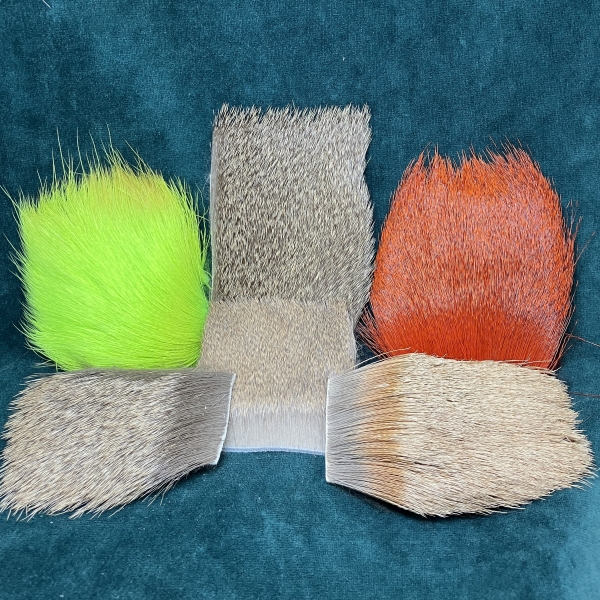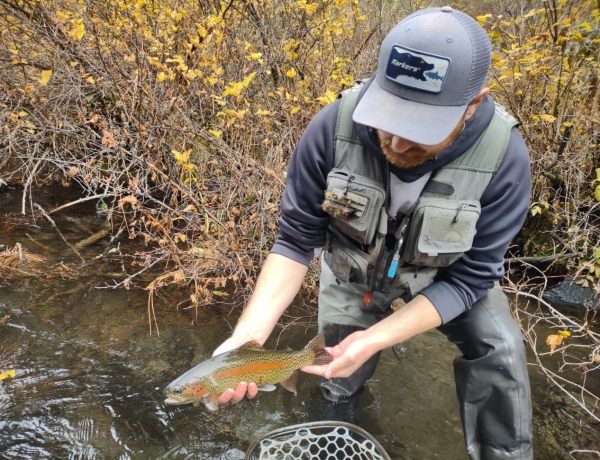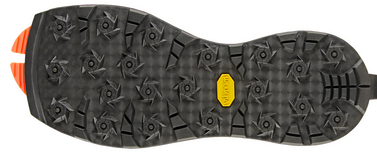October caddis in central Oregon are found in every moving body of water at varying degrees of abundance. They can be fished year-round as a subsurface fly, but in most rivers they become most important to fish from late August til the end of October. The Metolius has similar hatch timing for the nymph, but the adults can be fished for a much longer period of time than other rivers, sometimes all the way until March. On the Metolius, and to a lesser extent the Fall, there is another cousin to the October caddis called a silver striped sedge. It is slightly smaller (a size 10 or so compared to a 6 or 8) and more orange in color but it follows the same life cycle. The advice about fishing October caddis that follows also holds true for the silver striped sedge.
Nymph/larvae
The October caddis larvae, or nymphs, create a case of things like pine needles and pebbles and graze on detritus like dead leaves and algae on the bottom of the river. They are pretty much always cased, so imitations of them look more like their cases than the actual bug itself. They are moderately available to trout throughout the year, but when they begin to pupate is when they are most available to trout.
Pupa
Caddis are different from mayflies and stoneflies in that they have a pupal stage. Instead of a life cycle consisting of egg --> larva --> adult, like the mayflies and stoneflies, caddisflies pupate in between the larva and adult stage. October caddis are no different, but they are very large compared to most other caddis species. This bit of knowledge is important to anglers because in order to pupate, the October caddis larvae will crawl from their homes in deeper, faster water, to shallow slow water near the bank to seal themselves up in their cases and transform like Octoberus Prime. When they do this, they end up in the drift more often than usual, often sans case. Starting around the end of August, a dead drifted pupa can be very effective on rivers in central Oregon.
Adult
The adult October caddis is hard to confuse with other bugs that hatch in fall, since it's much bigger than all other caddis/mayfly/stones you might see in the fall. They emerge at night, so there isn't really an emergence you can fish. Once they are out and flying around, they are very sporadic in how they return to the river. They also oviposit late in the day and into the night, so you won't see swarms of October caddis laying eggs on the water and bringing trout up like a normal hatch. Sometimes you won't see any flying, just sitting on the streamside vegetation. Sometimes you'll see them during the day just bouncing along the surface of the water. So...when do you know when to fish the dry? Well, you don't, really. It's anyone's guess whether trout will pay attention to them on any given day. I personally have never seen trout consistently rising to these bugs, but I have heard from other anglers about days when there were a lot of naturals on the water and you could target rising fish. What I do know is that if you want to fish big dries, the big caddis are pretty much your only option when they're around. The Metolius has the best hatch of them, starting perhaps mid-late October and going through February for the dries. I have also caught fish with October caddis dries on the Deschutes and the Mckenzie, typically on warmer overcast days from late September through the beginning of November. They might not put the most fish in the net, but you won't know unless you fish one, so get adventurous and you could luck into some nice fish on big dries when other people are fishing smaller flies.


